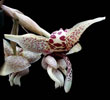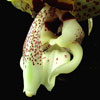|
|
|
|
|
| |
Established Seedlings of
Stanhopea hernandezii 'Hennis' × 'Kerspe' |
|
| |
|
|
| |
| Number: |
TN4057 |
| Name: |
Stanhopea hernandezii 'Hennis' × 'Kerspe'
|
| Type: |
outcross (What's that?) |
|
Seed Donor: |
Dale Borders
|
|
Click to Enlarge

Pod Parent Flower |
Click to Enlarge

Pollen Parent Flower |
Click to Enlarge

Pollen Parent Closeup of Labellum and Column |
|
|
|
| |
Culture Notes from Donor: Parent plants: Temperature range I (60-83°F)
Comments: Pollen parent plant: The flowers have the scent of stale mint.
For additional origin/habitat information supplied courtesy of
Charles and Margaret Baker, see further below, near the bottom of this page.
|
Temperatures we attempt to use in the lab & greenhouse:
| For Species: |
|
Spring, Summer, Autumn: days average 80°F, nights 58°F; best fit is Cool-Intermediate 75-58°F
(Source:
Baker's Web OSC) |
| For Species: |
|
Winter: days average 77°F, nights 47°F; best fit is Cool 70-52°F
(Source:
Baker's Web OSC) |
|
About the name...
| Etymology of |
hernandezii |
|
In honor of Francisco Hernandez, who made the first known European illustration of any Stanhopea, calling this plant by its Aztec name, Coatzonte Coxochitl. This work was done between 1570 and 1575.
(Source:
Greer 1998) |
| Etymology of |
Stanhopea |
|
In honor of Philip Henry, 4th Earl of Stanhope, president of the London Medico-Botanical Society during the early part of the 19th century.
(Source:
Pridgeon 1992) |
| Pronunciation of |
hernandezii |
|
her-NAN-dez-ee-eye
(Source:
Hawkes 1978) |
| Pronunciation of |
Stanhopea |
|
stan-HOPE-ee-ah
(Source:
Pridgeon 1992) |
|
If you would like to direct someone to this web page, please copy and paste this URL into your email:
http://troymeyers.com/d?124057
|
ESTABLISHED SEEDLINGS
of these are not currently available, but we have some maturing in the greenhouse and expect to offer them in the future.
There are 0 items with
plants per
item that will be considered for sale later.
Click here to see if we have flasks available.
|
|
|
| |
The origin/habitat information below is supplied courtesy of Charles and Margaret Baker
The following information is based on the name of the plant provided by the donor, and assumes that the name is correct. If the plant has been misidentified, then the following information may not be correct.
This text is copyrighted by the Bakers and may not be reproduced without permission.
ORIGIN/HABITAT: Mexico and Guatemala. In Guatemala, plants identified as
S. devoniensis Lindley were growing epiphytically on trees and on rocks in
forests at elevations up to 6250 ft. (1900 m).
In Mexico, plants previously known as S cavendishii Lindley have been
found in the states of Veracruz, Hidalgo, Puebla, Morelos, Michoacan,
Oxaca, and Chiapas. Although S hernandezii was the first Stanhopea
discovered in Mexico, details of habitat location and elevation are
amazingly lacking in the literature. In his 1975 Orchid Digest article,
George Kennedy reported finding this species in the mountains some 18
miles (30 km) south of Chilpanzingo (Chilpancingo) in the state of
Guerrero on the road to Acapulco. He stated that he was later unable to
find additional specimens of this species in the relatively low passes
along this highway in this region but indicated that plants were
reportedly more numerous in the higher, better-watered, but relatively
inaccessible areas of this mountain range to as far north as Tepic.
Habitat elevation in Mexico has not been reported, so we have estimated it
at 5500 ft. (1680 m) based on the reported elevation in nearby Guatemala.
The conditions indicated in the following table should be used somewhat
cautiously, however.
More about this information and the Bakers...
|
|
|
| |
|
|
|